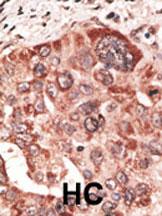Recoverin Antibody (C-term)
Purified Rabbit Polyclonal Antibody (Pab)
- 产品详情
- 实验流程
- 背景知识
Application
| WB, IHC-P, E |
|---|---|
| Primary Accession | P35243 |
| Reactivity | Human |
| Host | Rabbit |
| Clonality | Polyclonal |
| Isotype | Rabbit IgG |
| Calculated MW | 23130 Da |
| Antigen Region | 169-200 aa |
| Gene ID | 5957 |
|---|---|
| Other Names | Recoverin, Cancer-associated retinopathy protein, Protein CAR, RCVRN, RCV1 |
| Target/Specificity | This Recoverin antibody is generated from rabbits immunized with a KLH conjugated synthetic peptide between 169-200 amino acids from the C-terminal region of human Recoverin. |
| Dilution | WB~~1:1000 IHC-P~~1:100~500 E~~Use at an assay dependent concentration. |
| Format | Purified polyclonal antibody supplied in PBS with 0.09% (W/V) sodium azide. This antibody is prepared by Saturated Ammonium Sulfate (SAS) precipitation followed by dialysis against PBS. |
| Storage | Maintain refrigerated at 2-8°C for up to 2 weeks. For long term storage store at -20°C in small aliquots to prevent freeze-thaw cycles. |
| Precautions | Recoverin Antibody (C-term) is for research use only and not for use in diagnostic or therapeutic procedures. |
| Name | RCVRN |
|---|---|
| Synonyms | RCV1 |
| Function | Acts as a calcium sensor and regulates phototransduction of cone and rod photoreceptor cells (By similarity). Modulates light sensitivity of cone photoreceptor in dark and dim conditions (By similarity). In response to high Ca(2+) levels induced by low light levels, prolongs RHO/rhodopsin activation in rod photoreceptor cells by binding to and inhibiting GRK1-mediated phosphorylation of RHO/rhodopsin (By similarity). Plays a role in scotopic vision/enhances vision in dim light by enhancing signal transfer between rod photoreceptors and rod bipolar cells (By similarity). Improves rod photoreceptor sensitivity in dim light and mediates response of rod photoreceptors to facilitate detection of change and motion in bright light (By similarity). |
| Cellular Location | Photoreceptor inner segment {ECO:0000250|UniProtKB:P34057}. Cell projection, cilium, photoreceptor outer segment {ECO:0000250|UniProtKB:P34057}. Photoreceptor outer segment membrane {ECO:0000250|UniProtKB:P21457}; Lipid-anchor {ECO:0000250|UniProtKB:P21457}; Cytoplasmic side {ECO:0000250|UniProtKB:P21457}. Perikaryon {ECO:0000250|UniProtKB:P34057}. Note=Primarily expressed in the inner segments of light-adapted rod photoreceptors, approximately 10% of which translocates from photoreceptor outer segments upon light stimulation (By similarity). Targeting of myristoylated protein to rod photoreceptor outer segments is calcium dependent (By similarity) {ECO:0000250|UniProtKB:P21457, ECO:0000250|UniProtKB:P34057} |
| Tissue Location | Retina and pineal gland. |
For Research Use Only. Not For Use In Diagnostic Procedures.
Provided below are standard protocols that you may find useful for product applications.
BACKGROUND
Recoverin belongs to a high-affinity calcium-binding family that includes neuronal calcium sensor-1, visinin-like proteins (VILIPs), guanylate cyclase-activating proteins (GCAPs), and Kv-channel interacting proteins (KchIPs). Features common to this family include four calcium-binding EF-hand domains, and an N-terminal myristoylation sequence. This family of proteins has been implicated in a broad range of cellular signaling functions, including phototransduction and neurotransmitter release, lipid metabolism, gene expression, and ion channel regulation. Myristoylation, the post-translational addition of a fatty acid tail, has been shown to have functional significance for other calcium-binding protein family members. Recoverin is subject to the posttranslational modification of myristoylation. Binding of calcium to recoverin elicits a change in conformation that exposes the buried hydrophobic myristoyl moiety to interaction with cell membranes and other cellular proteins.
REFERENCES
Wiechmann, A., et al., Curr. Eye Res. 26(1):25-32 (2003). Matsubara, S., et al., Br. J. Cancer 74(9):1419-1422 (1996). Yamaji, Y., et al., Int. J. Cancer 65(5):671-676 (1996). McGinnis, J.F., et al., Mamm. Genome 4(1):43-45 (1993). Wiechmann, A.F., et al., Exp. Eye Res. 56(4):463-470 (1993).
终于等到您。ABCEPTA(百远生物)抗体产品。
点击下方“我要评价 ”按钮提交您的反馈信息,您的反馈和评价是我们最宝贵的财富之一,
我们将在1-3个工作日内处理您的反馈信息。
如有疑问,联系:0512-88856768 tech-china@abcepta.com.























 癌症的基本特征包括细胞增殖、血管生成、迁移、凋亡逃避机制和细胞永生等。找到癌症发生过程中这些通路的关键标记物和对应的抗体用于检测至关重要。
癌症的基本特征包括细胞增殖、血管生成、迁移、凋亡逃避机制和细胞永生等。找到癌症发生过程中这些通路的关键标记物和对应的抗体用于检测至关重要。 为您推荐一个泛素化位点预测神器——泛素化分析工具,可以为您的蛋白的泛素化位点作出预测和评分。
为您推荐一个泛素化位点预测神器——泛素化分析工具,可以为您的蛋白的泛素化位点作出预测和评分。 细胞自噬受体图形绘图工具为你的蛋白的细胞受体结合位点作出预测和评分,识别结合到自噬通路中的蛋白是非常重要的,便于让我们理解自噬在正常生理、病理过程中的作用,如发育、细胞分化、神经退化性疾病、压力条件下、感染和癌症。
细胞自噬受体图形绘图工具为你的蛋白的细胞受体结合位点作出预测和评分,识别结合到自噬通路中的蛋白是非常重要的,便于让我们理解自噬在正常生理、病理过程中的作用,如发育、细胞分化、神经退化性疾病、压力条件下、感染和癌症。







